Temples full of legends and traditions, Buddha statues dominating the stage, royal palaces where everything seems perfect: a magical world to discover. Discover all the best things to do in Bangkok and its surroundings! Let yourself go to a dynamic city with strong traditions, among streets full of people and wonderful architectural details. You will also have the opportunity to make numerous excursions around Thailand, possibly starting from the city of Laem Chabang.
Wat Pho
The very famous Wat Pho (Temple of the Reclining Buddha), also known as Wat Phra Chetuphon, is shown to visitors immediately after another symbolic place, the Temple of the Emerald Buddha: it is a must for any visitor who wants to discover Bangkok from the first visit. In this case, this is the area where the main temples of the city are located. It is here that the colossal reclining Buddha, 46 meters long, covered with golden leaves, shines with its special light. In short, there is something to see. We must not forget that in Wat Pho you can also visit a traditional Thai massage. This is considered the best massage school in Thailand, so be careful. In any case, the point of greatest interest coincides with the reclining Buddha.
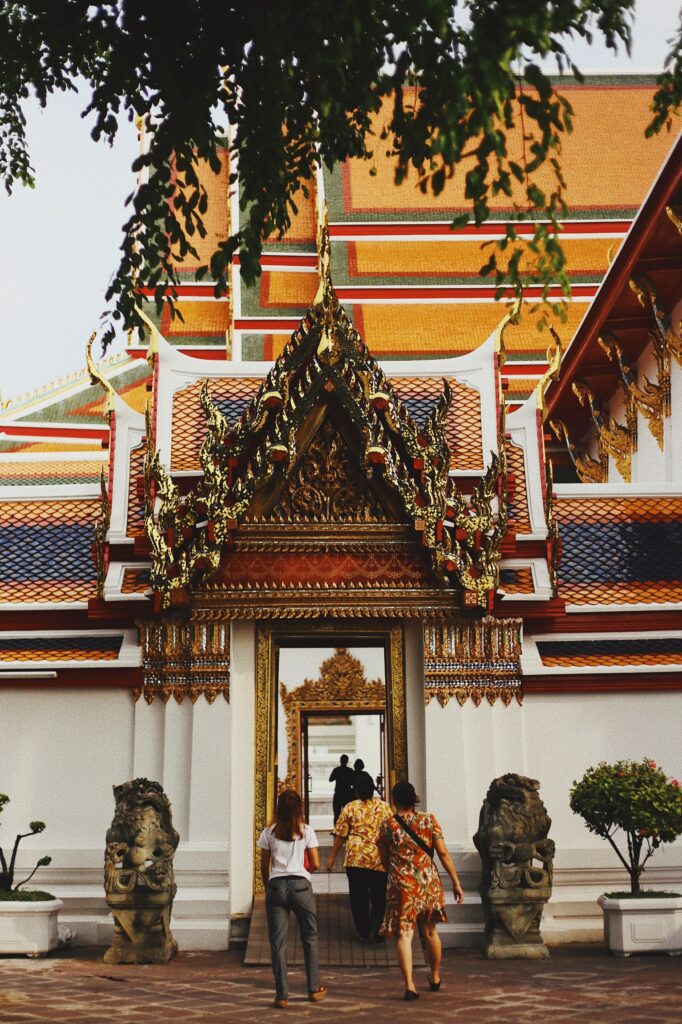

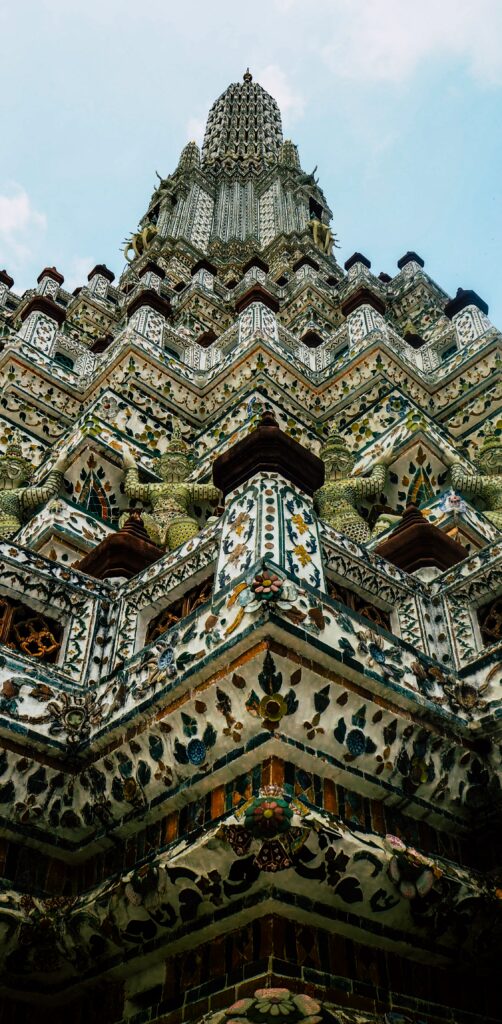
Gigantic work: suffice it to say that her five-meter-long legs are decorated with mother-of-pearl drawings and are considered a good omen. The number 108 always appears, as do the positive actions that led the Buddha to perfection. At the entrance, try to find your luck by throwing a few coins into 108 bronze bowls lined up along the walls. Inside the structure, it is also strongly recommended to visit four chapels, which contain 394 golden Buddha images arranged in long rows. Finally, in the courtyards of Wat Pho Temple, there are Chinese statues, once used as ballast on ships.
Grand Royal Palace
Thousands of visitors seem to be gathering in the Grand Palace. It is the center of all the tourist gems of the city, a complex of buildings in the heart of Bangkok. The palace hosted members of the royal family of the ancient Kingdom of Siam from 1782 to 1925. Currently, the residence of King Bhumibol Adulyadej is located in the Chitralada Palace, but official events take place in the Grand Palace, and in any case, it remains the main attraction of Thailand. We are located in the Phra Nakhon district, 218,000 square meters is occupied by a building to its maximum extent, including pavilions, halls, gardens, and museums.

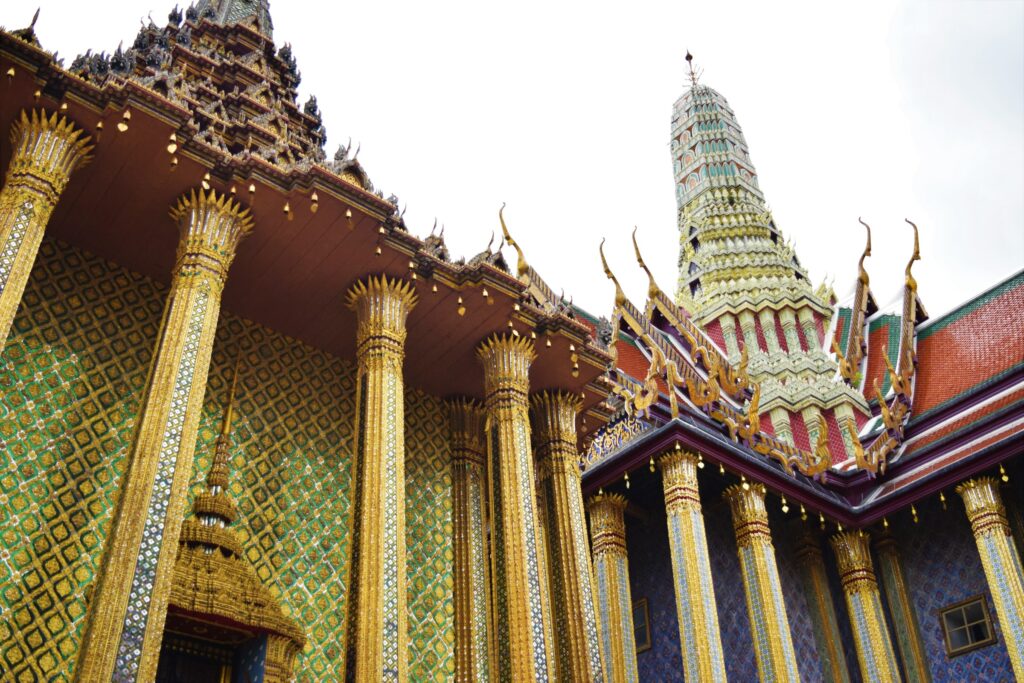
In the center is the Phra Maha Monthien district with traditional buildings in the local style, including the royal house. In the Phra Maha Chakri area, we find palaces that are a mixture of Thai and European architecture. The oldest buildings are located in Phra Maha Prasat, enriched with new decorative details over the years. One of the most famous places is the Temple of the Emerald Buddha, while the open space in the eastern part of the courtyard is occupied by gardens, and inside there are ceremonial halls and the throne room.
Emerald Buddha Statue
Here we are at the holiest temple in all of Thailand, exactly in the center of Bangkok, Phra Nakhon district. Officially, it is called Wat Phra Sri Rattana Satsadaram, or “the residence of the sacred jewel of the Buddha.” This is also a complex of religious buildings inside the Grand Royal Palace. There is a sacred statue of the Emerald Buddha in it. Legend has it that the statue was created in India, where the sage (Nagasena) prophesied that it would bring great prosperity to the country that sheltered it. That is why he enjoys great veneration in Thailand. Its color is dark green (the material is jade, not emerald) and depicts the Buddha in a meditative pose. No one can touch the statue except the King of Thailand and the Crown Prince.

Since 1238, that is, since the beginning of Sukhothai’s reign, temples have been built on the walls guarding the royal palaces. The ancient name of the capital, Rattanakosin, means “city of jewels” concerning the precious statue, in addition, the whole country (the Kingdom of Siam) was called this way until the name Thailand was adopted in 1939. Wat Phra Keo consists of one hundred buildings on the fenced territory of a Large Royal Palace. It also houses the best examples of Buddhist sculpture, architecture, and painting.
Phra Ubosot Temple, where the emerald statue is located, is truly majestic due to its colorful and precious decorations. Once the Buddha statue was carried around the city, but the tradition was interrupted for fear of damage. On the other hand, the ceremony of dressing the Emerald Buddha persists with every change of season.
Wat Arun
The temple that strikes the imagination of every tourist is certainly Wat Arun, majestic in its beauty, which comes out of the banks of the Chao Phraya River, in the popular Thonburi district, so this place is very often visited by believers. Do you want to know his full name? Get ready: it’s called Wat Arunratchavararam Ratchavoramahavihara. The first thing that catches your eye when looking at it from afar is its spires and ledges. The central one, the highest, has been enlarged over the years, going from the original 16 meters to the current 81 meters. On four sides, steep stairs allow you to reach three levels of balconies, and climbing them will be a bit like moving on a cloud due to the effect of white plaster.

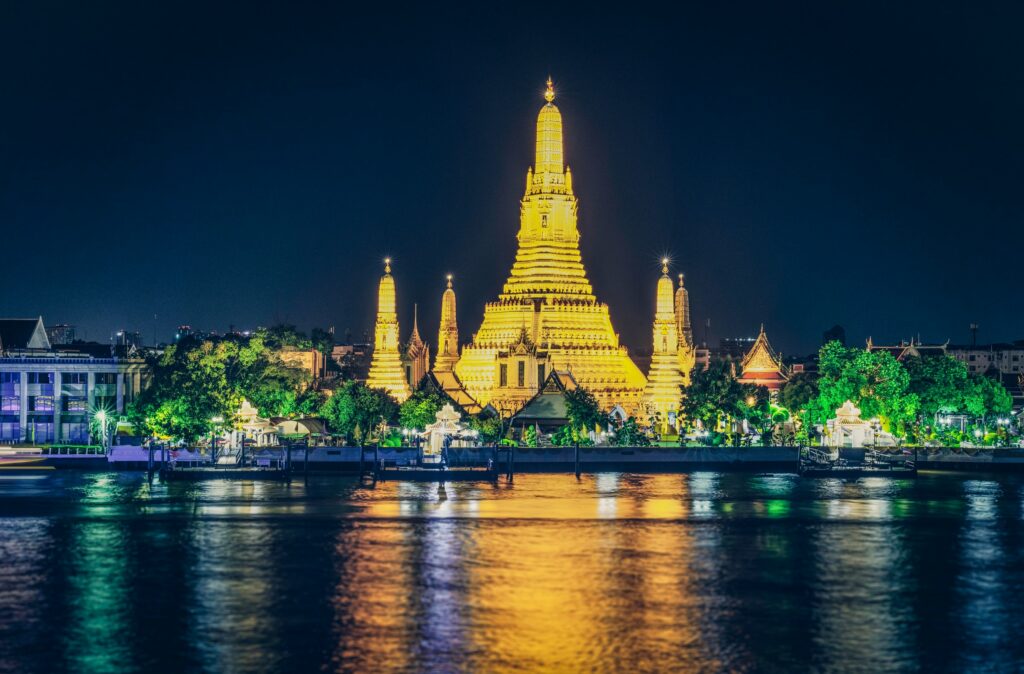

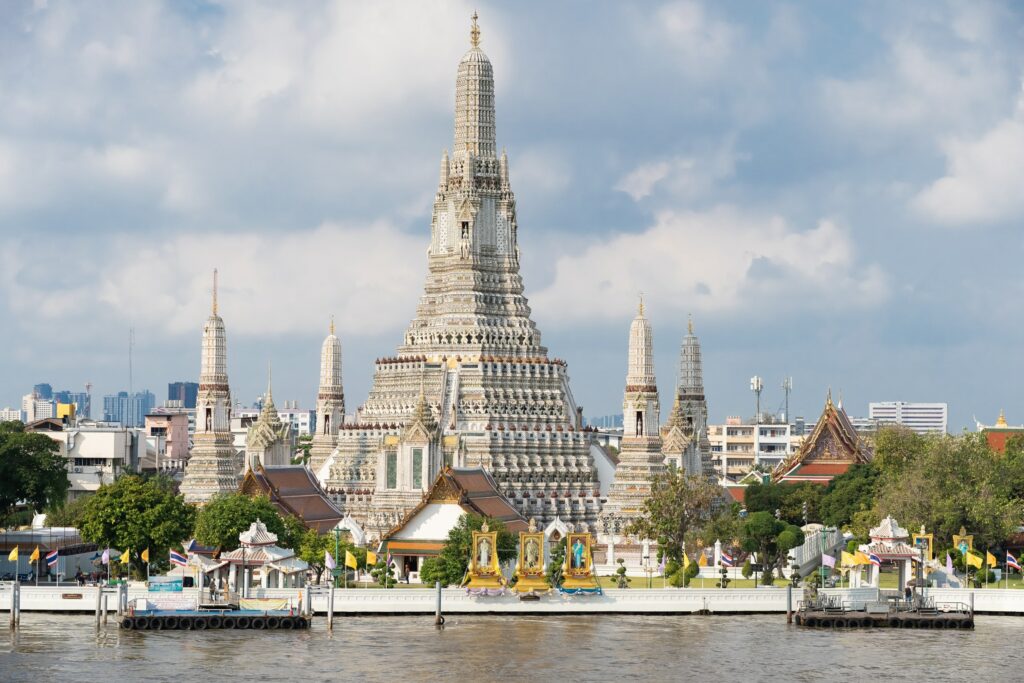
On the first terrace, we find a series of caryatids depicting Yaksha deities and scenes from the life of the Buddha, interspersed with the famous Kinnar statues, creatures half human and half bird. On the second balcony, the caryatids become monkeys, on the third — a very small one — there are four niches with four statues of the god Indra, a Hindu warrior deity who rides a three-headed elephant named Erawan. From here you can admire the magnificent full panorama of Thonburi and Chao Phraya, as well as see the whole of Bangkok.
Wat Saket on the Golden Mountain
Another privileged point of observation of the city, is from the top of an artificial hill, from which rises the Golden Mountain, or Phu Khao Thong, a tourist attraction and another symbol of Bangkok. A golden dome shines outside, and an important relic of the Buddha is inside. Monte Dorato was once the highest point, but even today with skyscrapers it is the best place from where a 360-degree view of the entire territory opens. Looking to the west, you can see Rattanakosin Island with a Large Palace, Wat Phra Keo, and Wat Arun temples. Nearby is Var Suthat, a giant swing, and the golden spires of Loha Prasat. To the east, you can admire the skyline of the skyscrapers of Siam and Silom.
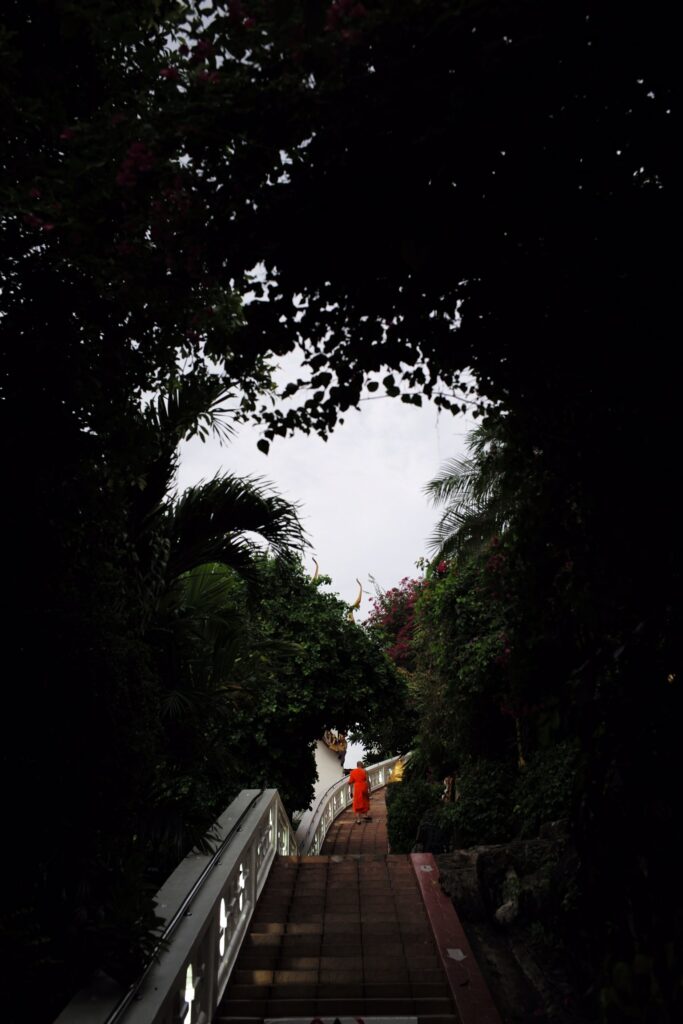

The temple dates back to the Ayutthaya era and was known as Wat Sakae. The original structure collapsed on the soft ground, and in the following decades, these fragments formed a hill and then strengthened, on which King Rama IV completed the new building. Note that the modern Wat Saket was built in the early 20th century from Carrara marble. The hill is now surrounded by two large spiral staircases, one of which can be climbed and the other descended. Along the way, you will meet flower gardens, waterfalls, and a terrace full of bells with magnificent gongs, which are traditionally played by making a wish.
In the large room, there is also an oracle corner, where numbered sticks promise to predict the future. This is a recurring tradition in many temples. Next to the hill, we find Wat Saket, a much less visited complex, where, however, Buddhist scriptures have been preserved and the residences of monks are located. Every November there is a festival with colorful lanterns, flags, and kiosks throughout the week.
Khao San Road
The “ground rice” road is so named because it was once a viaticum of rice, a center of activity. The first hotel opened to accommodate employees who came from the province, then others followed when the street became a “religious street” due to the presence of many shops for accessories for monks. Today, of course, trade has reached a much larger size, and the offer has been expanded to tourism. There are restaurants of all sizes, new hotels, and coastal cottages. We are always in the Rattanakosin district, in the historical center of Bangkok. There is no shortage of attractions.
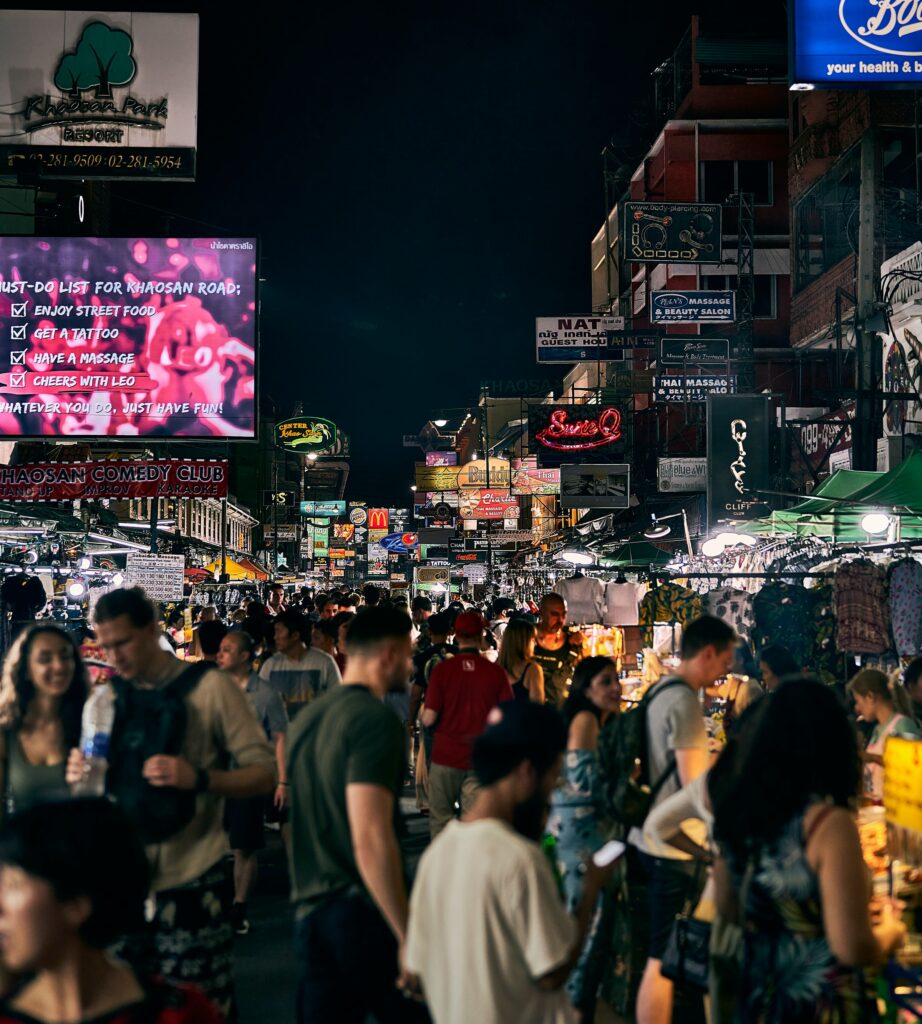
It starts from the Democracy Monument and continues with the Memorial on October 14 (when the protests against the dictatorship of Thanom Kittikachorn drowned in blood in ’73), Phra Sumen Fort with the last tower of the historic city walls, Santichayprakan Park, Sunset Street Art Gallery, Wat Bovonniwet Temple with a beautiful image of Buddha dating from 1375 and Wat Temple Chana Songkhram.
Jim Thompson’s House
The American architect collaborated with the US Army in the operation to liberate Thailand. After the war, remaining in Bangkok, he began an entrepreneurial activity that contributed to the spread of Thai silk in the world, meanwhile, he developed his passion for collecting, and collecting an important selection of Buddhist works of art. Disappeared in 1967 during a trip to Malaysia, he left a house consisting of six traditional houses from different provinces and dating back two centuries earlier. Today, the house, raised and surrounded by gardens, is open to the public and allows you to learn art and architecture related to local traditions. We are located in the Patumwan district, and the Thompson House has become a city museum.

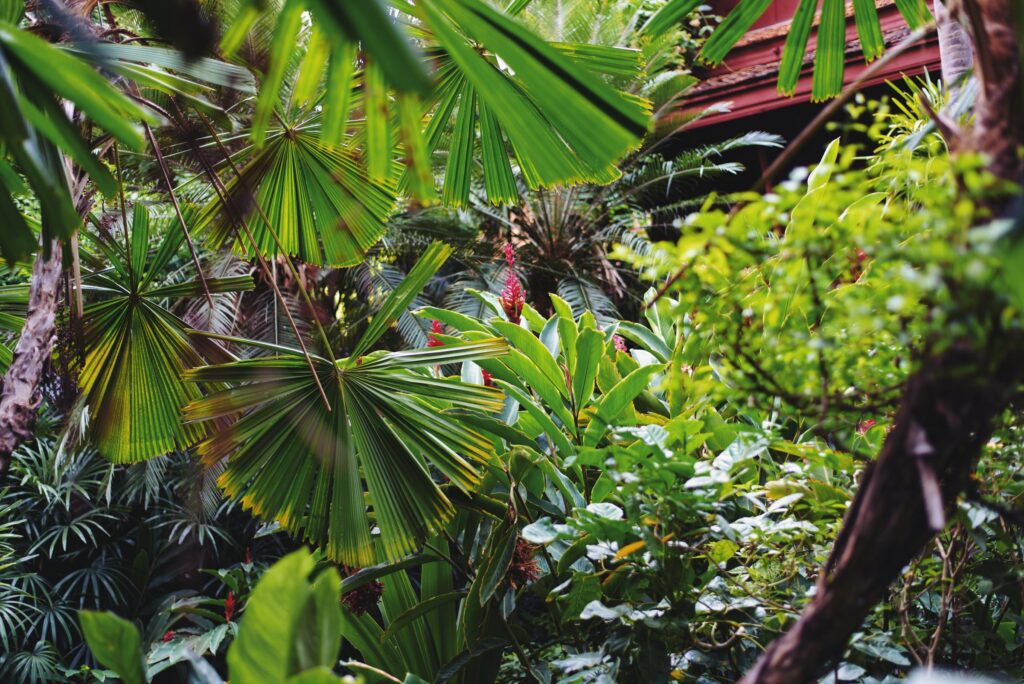

Tuk-tuk ride
What is a tuk-tuk? This is a three-wheeled taxi, with a roof, but open on the sides, with one seat for the driver and three at the back for passengers. It is very popular in almost all of Asia. It fascinates tourists because it is colorful and decorated, absolutely characteristic. But be careful before getting on board — drivers often drive them at full speed through traffic jams and local streets. There are a lot of them at the exit from the Royal Palace, but not only. Of course, if you are looking for efficiency, comfort, and safety, you will have to use another vehicle. It is not uncommon to see scenes in which a driver gets up from his seat to push a car that has broken down, possibly with guests on board.
Undoubtedly, the tuk-tuk ride will be exciting and adrenaline-pumping. It is better to have travel insurance if you want to get this experience. The price is usually low, possibly by agreement, also taking into account possible mandatory stops in stores that the driver trusts. But a ride on this vehicle in Bangkok is simply necessary to rush through the streets of the capital in a riot of lights and colors, especially at night. It is better to use it for short trips, avoiding rush hour both because of the risk of accidents and because of the peak of smog. The tuk-tuk gastronomic tour has recently enjoyed great success after dark: a great opportunity to explore the surroundings and their local street food, see the hidden places of the city, and those preferred by the locals of Bangkok.
Chinatown
Bangkok’s Chinatown is one of the main attractions for visitors. Impressive and full of charm buildings, illuminated with colorful neon signs, but in the alleys between the houses there is no shortage of more traditional places and small Confucian temples, hidden for centuries in their quiet area. Probably the atmosphere of this area is very similar to the Chinatowns we find all over the world, but here we find some details that matter. First of all, from the point of view of the gastronomic offer. The number of restaurants is incredible, and a constant factor is quality at a low price. So, here’s a good enough reason to take a guided tour here mandatory.
Along with places offering the most popular dishes, such as Peking duck, there are others where the cuisine is halfway between Chinese and Thai. The combination of tastes is extraordinary, Chinatown is also a place for shopping. The commercial vocation of immigrants has led to the emergence of several avant-garde shops and centers in this sector, especially around Sampend Avenue. The inexpensive costume and jewelry sector is located in ThaiDee Plaza.



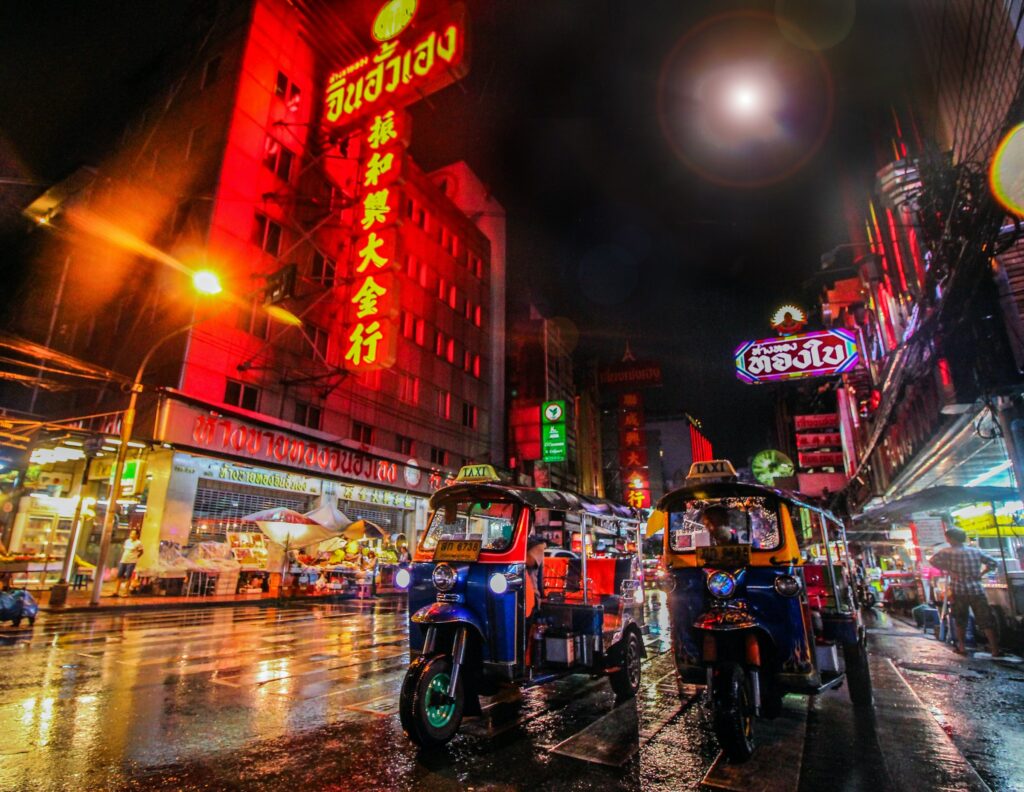
Among the open-air markets, perhaps the most famous are Nakom Kasem and Sampeng Lane, located on a narrow and very extensive pedestrian street, which also houses a fruit and vegetable market. There is no shortage of famous ancient Chinese pharmacies. To eat outdoors, you can choose That Malai restaurant, and you can watch crocodiles at Wat Chakravat Temple.
Nearby: Ayuthaya
The ancient capital is located less than eighty kilometers north of Bangkok. Its imposing ruins date back to four centuries when it was the most important city in Siam. Bang Pa-in Royal Palace with its beautiful gardens is still in excellent condition. Identified as the Venice of the East, it has been declared a UNESCO World Heritage Site due to its archaeological excavations. Numerous fortified palaces are located around the city walls, and outside there are forts lying on waterways. The old palace includes several important structures, such as Wat Phra Si Sanphet, originally used as a royal chapel, Vihan Phramonghon Bophit, which is a large bronze statue of Buddha, and finally Wat Ratchaburana, a temple located near the Pa Than Bridge.












